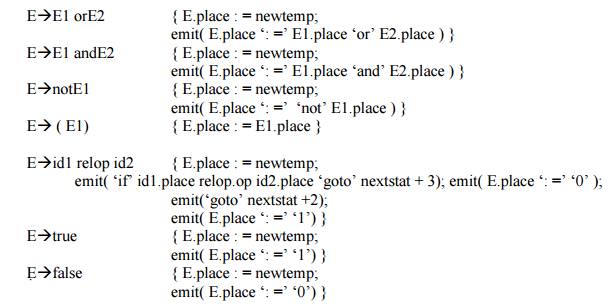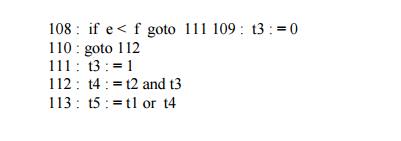Chapter: Principles of Compiler Design : Intermediate Code Generation
Boolean Expressions
BOOLEAN EXPRESSIONS
Boolean expressions
have two primary purposes. They are used to compute logical values, but more
often they are used as conditional expressions in statements that alter the
flow of control, such as if-then-else, or while-do statements.
Boolean expressions are
composed of the boolean operators ( and, or, and not ) applied to elements that
are boolean variables or relational expressions. Relational expressions are of
the form E1 relop E2, where E1 and E2 are arithmetic expressions.
Here we consider boolean expressions generated by
the following grammar :
E->EorE
| EandE |notE | ( E ) |id relop id | true | false
Methods of Translating Boolean
Expressions:
There are two principal methods of representing the
value of a boolean expression. They are :
* To
encode true and false numerically and to evaluate a boolean expression
analogously to an arithmetic expression. Often, 1 is used to denote true and 0
to denote false.
* To
implement boolean expressions by flow of control, that is, representing the
value of a boolean expression by a position reached in a program. This method
is particularly convenient in implementing the boolean expressions in
flow-of-control statements, such as the if-then and while-do statements.
Numerical Representation
Here, 1 denotes true
and 0 denotes false. Expressions will be evaluated completely from left to
right, in a manner similar to arithmetic expressions.
For example :
* The
translation for a or b and not c is the three-address sequence
* t1
: = not c
t2 : = b and t1
t3 : = a or t2
* A
relational expression such as a < b is equivalent to the conditional
statement
* if
a < b then 1 else 0
which can be translated
into the three-address code sequence (aga statement numbers at 100) :
100 : if a < b goto
103 101 : t : = 0
102 : goto 104
103 : t : = 1
104 :
Translation scheme using a numerical
representation for booleans

Short-Circuit Code:
We can also translate a boolean expression into
three-address code without generating code for any of the boolean operators and
without having the code necessarily evaluate the entire expression. This style
of evaluation is sometimes called “short-circuit” or “jumping” code. It is possible
to evaluate boolean expressions without generating code for the boolean
operators and, or, and not if we represent the value of an expression by a
position in the code sequence.
Translation of a < b
or c < d and e < f
100 : if a < b goto
103 101 : t1 : = 0
102 : goto 104 103 : t1
: = 1
104 : if c < d goto
107 105 : t2 : = 0
106 : goto 108
107 : t2 : = 1

Flow-of-Control Statements
We now consider the
translation of boolean expressions into three address code in the context of
if-then, if-then-else, and while-do statements such as those generated by the
following grammar:
S->ifEthenS1
|
if E then S1 else S2
|
while E do S1
In each of these productions, E is the Boolean
expression to be translated. In the translation, we assume that a three-address
statement can be symbolically labeled, and that the function newlabel returns a
new symbolic label each time it is called.
* E.true
is the label to which control flows if E is true, and E.false is the label to
which control flows if E is false.
* The
semantic rules for translating a flow-of-control statement S allow control to
flow from the translation S.code to the three-address instruction immediately
following S.code.
* S.next
is a label that is attached to the first three-address instruction to be
executed after the code for S.
Related Topics